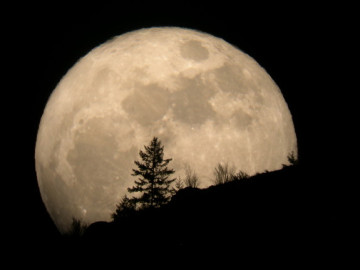video: NEW: Supermoon Tonight—14% Bigger and 30% Brighter
Saturday, May 05, 2012
It's the biggest this year... 14% larger and 30% brighter... and it's in Rhode Island skies tonight.
For those who missed last year's supermoon in March, this is a double-whammy of big and bright that makes our moon look especially large. Tonight, the moon will appear 14% larger than any other full moon of 2012. It will also be 30% brighter than any other moon this year.
NASA explains the Supermoon
"'Supermoon' is a situation when the moon is slightly closer to Earth in its orbit than on average, and this effect is most noticeable when it occurs at the same time as a full moon," said Dr. James Garvin, chief scientist at NASA's Goddard Space Flight Center, who answered questions regarding the phenomenon in a 2011 interview. "So, the moon may seem bigger although the difference in its distance from Earth is only a few percent at such times."
Garvin said the "super" in super moon "is really just the appearance of being closer, but unless we were measuring the Earth-Moon distance by laser rangefinders (as we do to track the LRO [Lunar Reconnaissance Orbiter] spacecraft in low lunar orbit and to watch the Earth-Moon distance over years), there is really no difference," he said. "The supermoon really attests to the wonderful new wealth of data NASA's LRO mission has returned for the Moon, making several key science questions about our nearest neighbor all the more important."
How supermoon affects Earth
The effects on Earth from a supermoon are minor, according to Garvin, and according to the most detailed studies by terrestrial seismologists and volcanologists, the combination of the moon being at its closest to Earth in its orbit, and being in its 'full moon' configuration (relative to the Earth and sun), should not affect the internal energy balance of the Earth since there are lunar tides every day.
"The Earth has stored a tremendous amount of internal energy within its thin outer shell or crust, and the small differences in the tidal forces exerted by the moon (and sun) are not enough to fundamentally overcome the much larger forces within the planet due to convection (and other aspects of the internal energy balance that drives plate tectonics)," Garvin said. "Nonetheless, these supermoon times remind us of the effect of our 'Africa-sized' nearest neighbor on our lives, affecting ocean tides and contributing to many cultural aspects of our lives (as a visible aspect of how our planet is part of the solar system and space)."
Watch NASA's cool supermoon video, here.
Related Articles
- NEW: Largest Full Moon in 18 Years To Rise Over Rhode Island Tonight
- April Meteor Showers + More
- Meteor Showers + More Predictions for 2012



